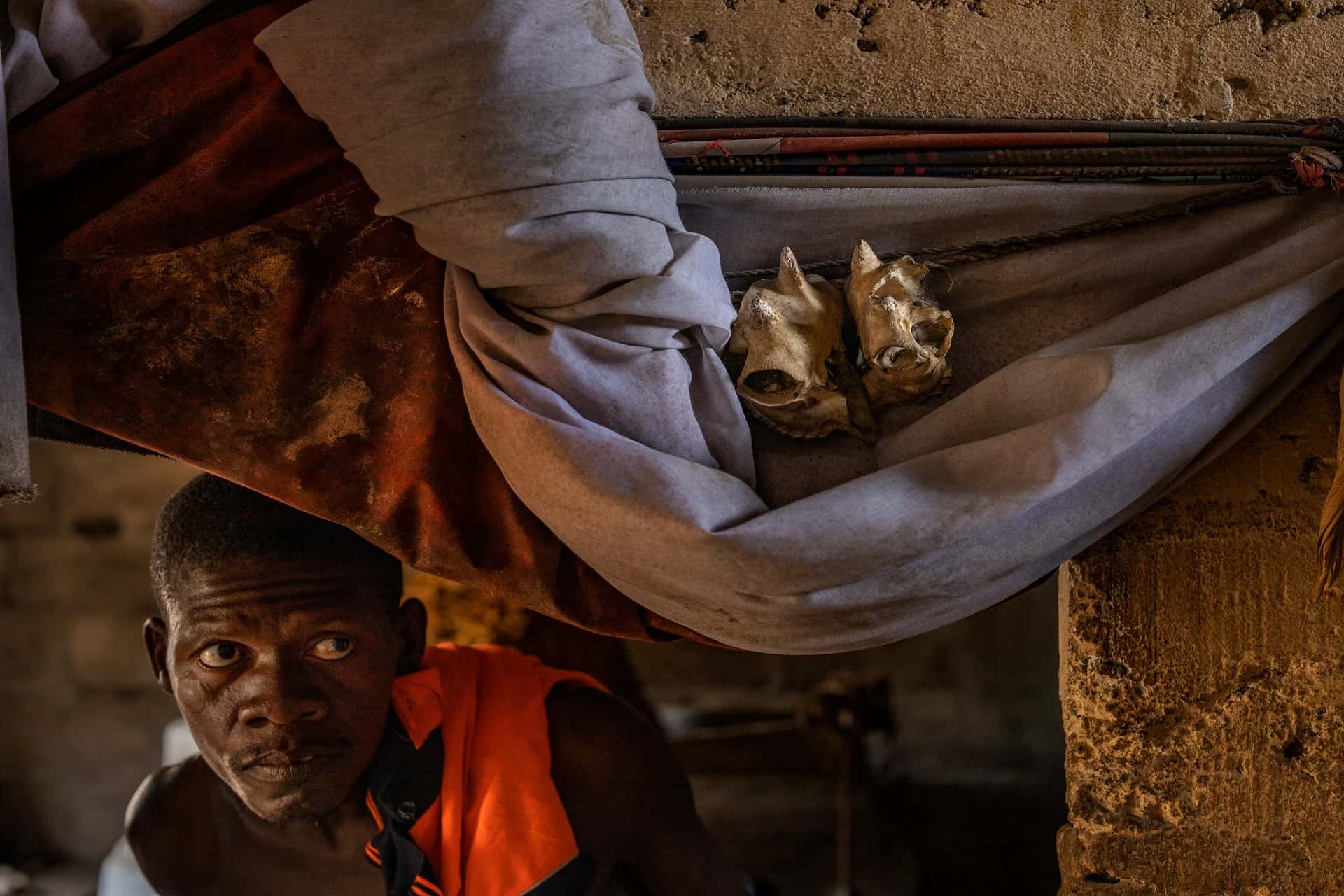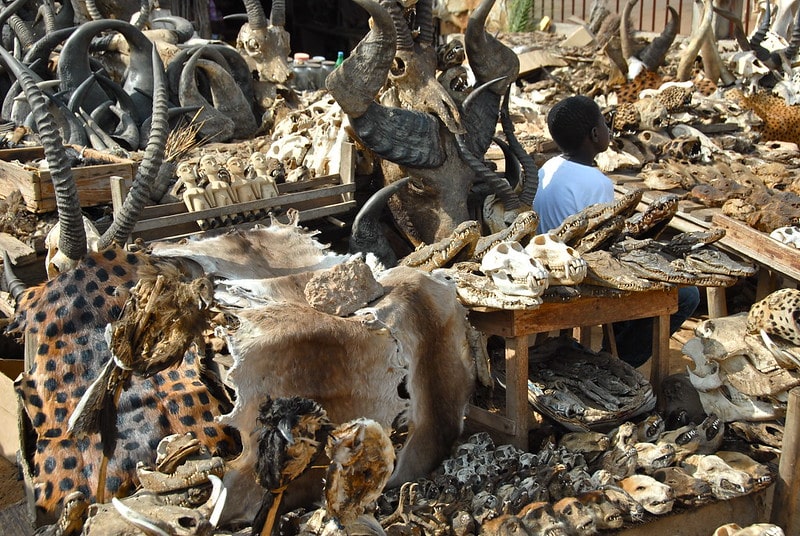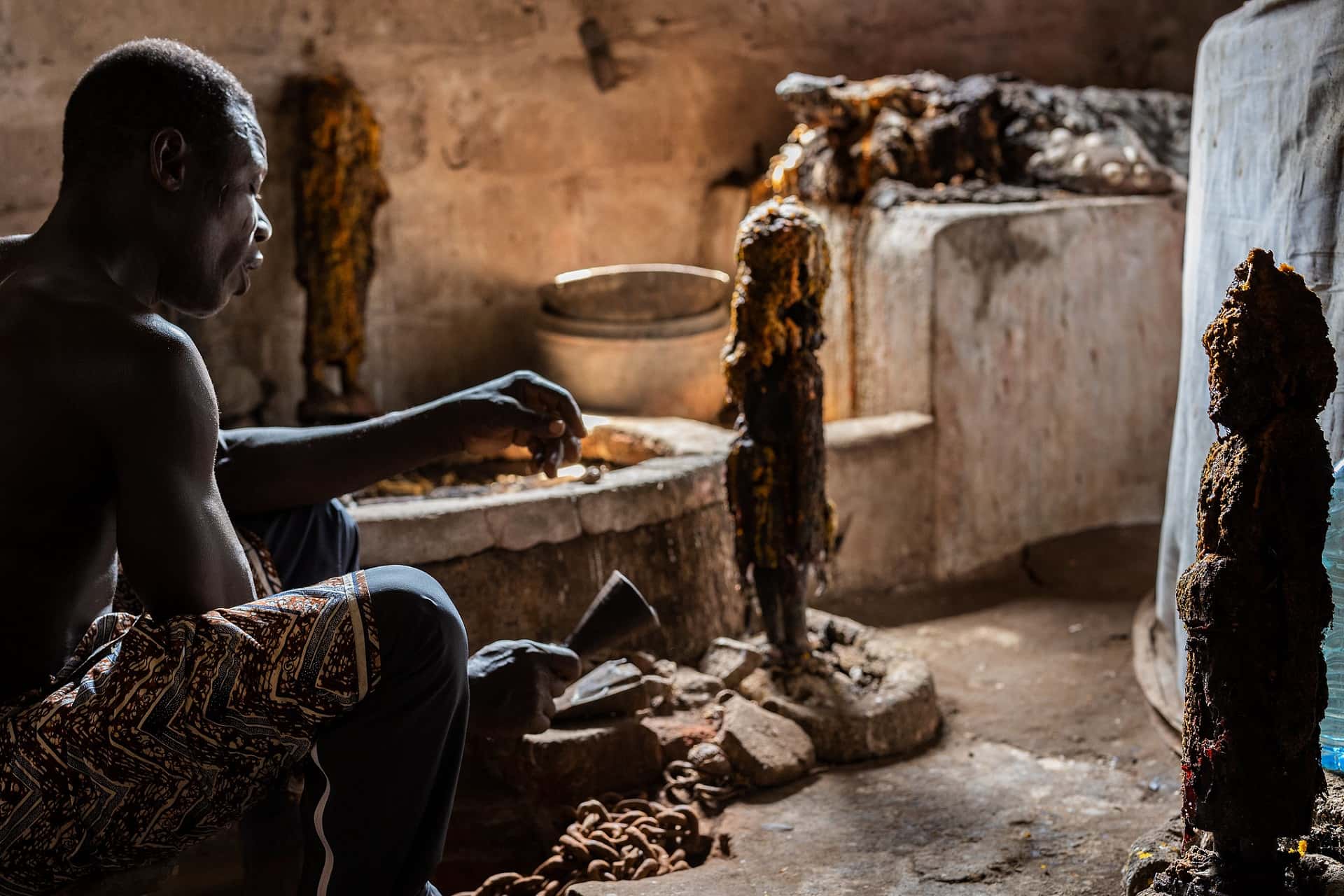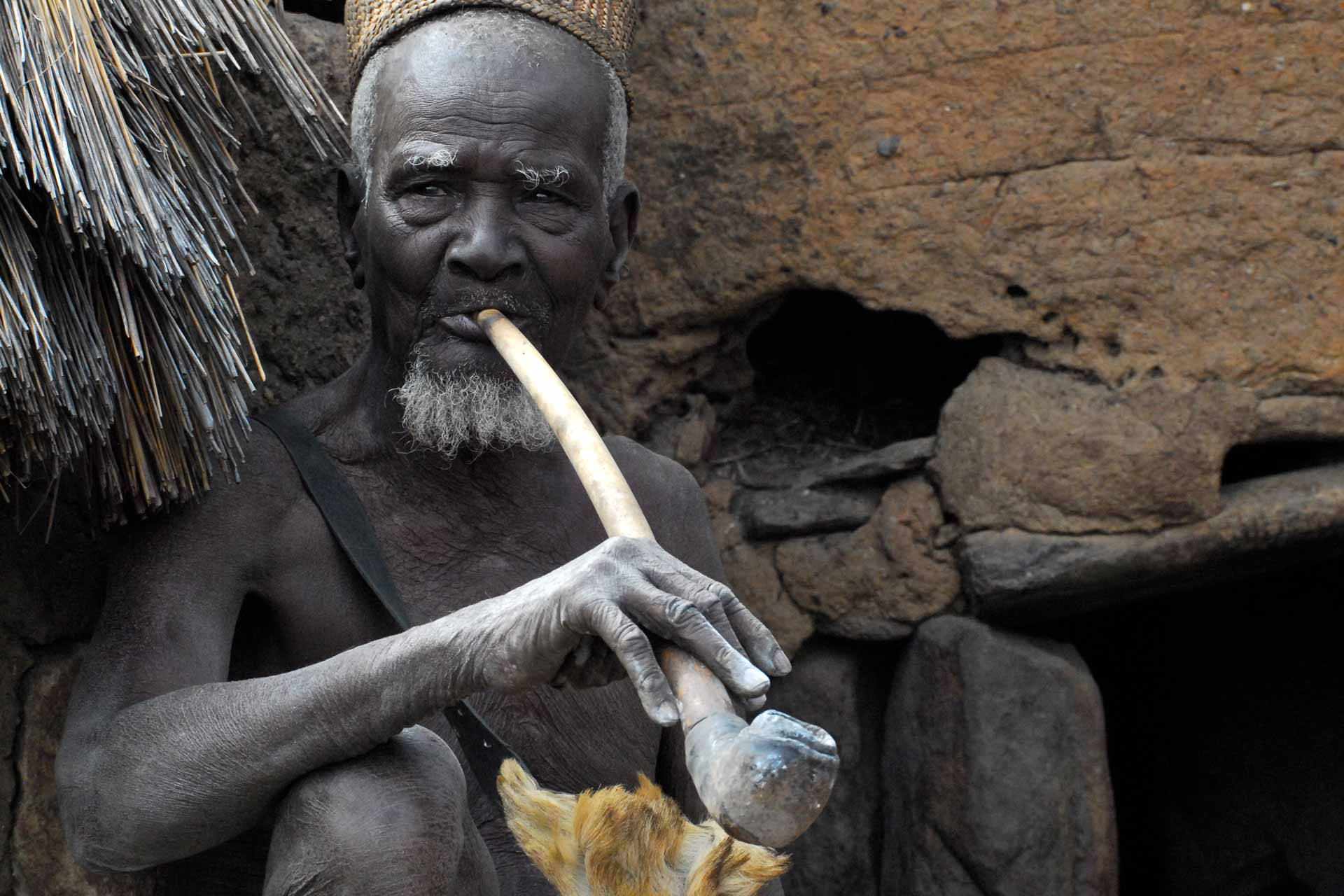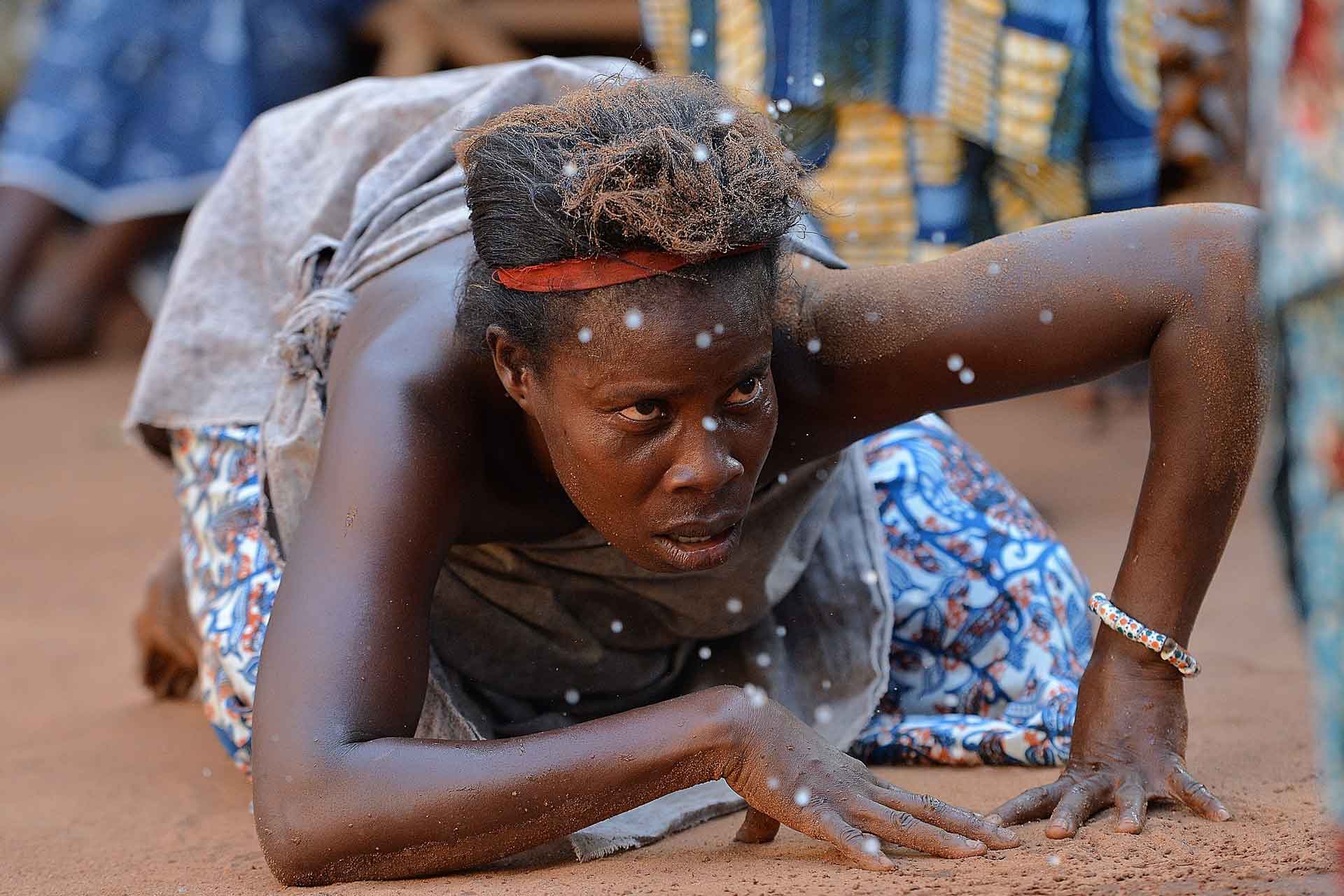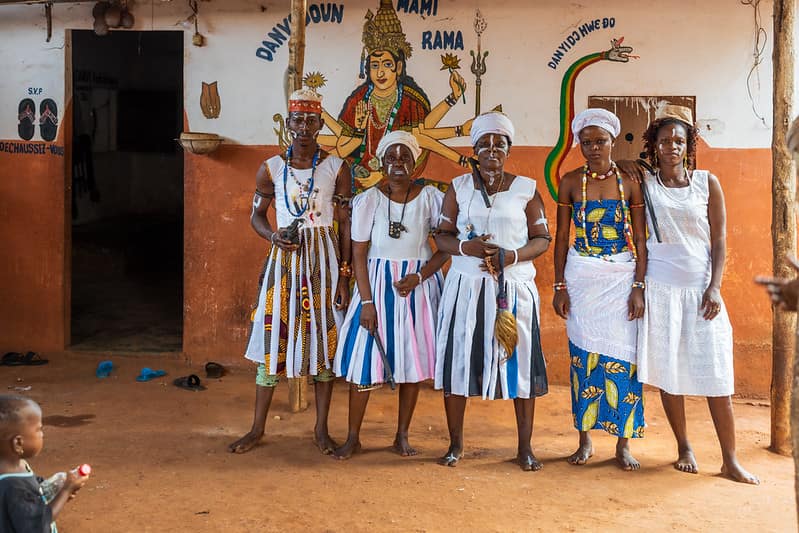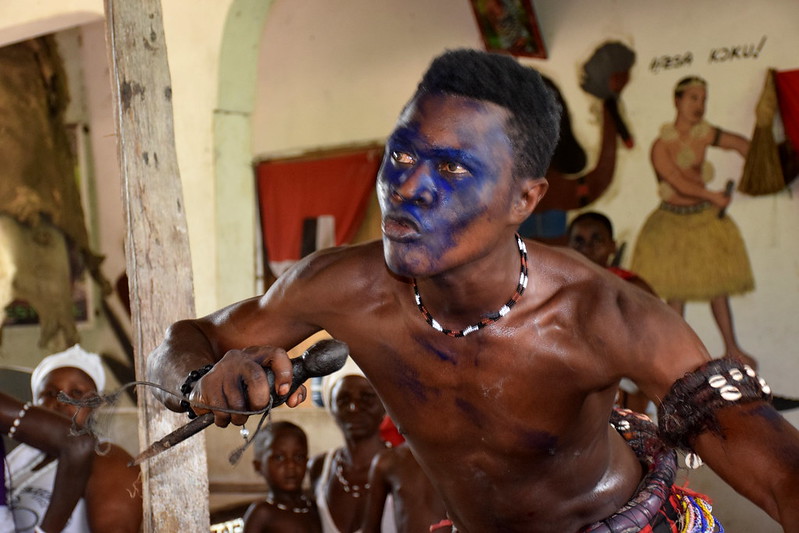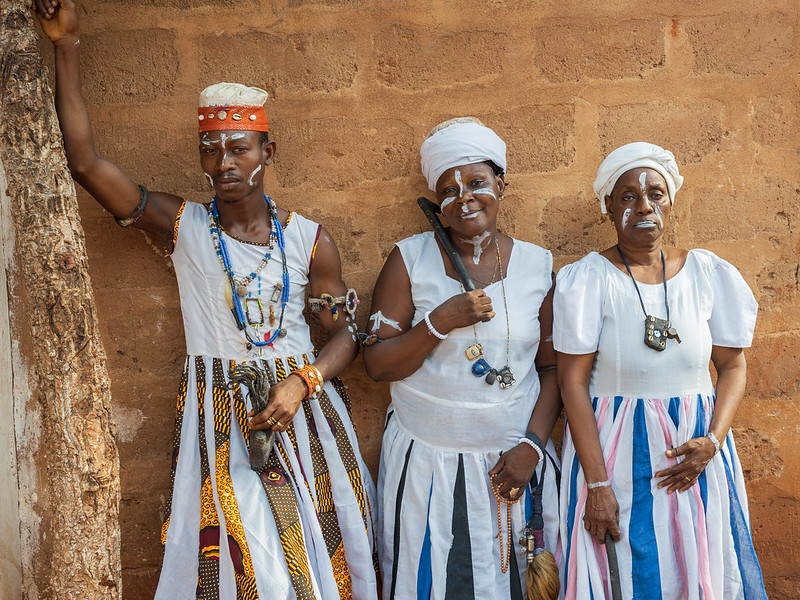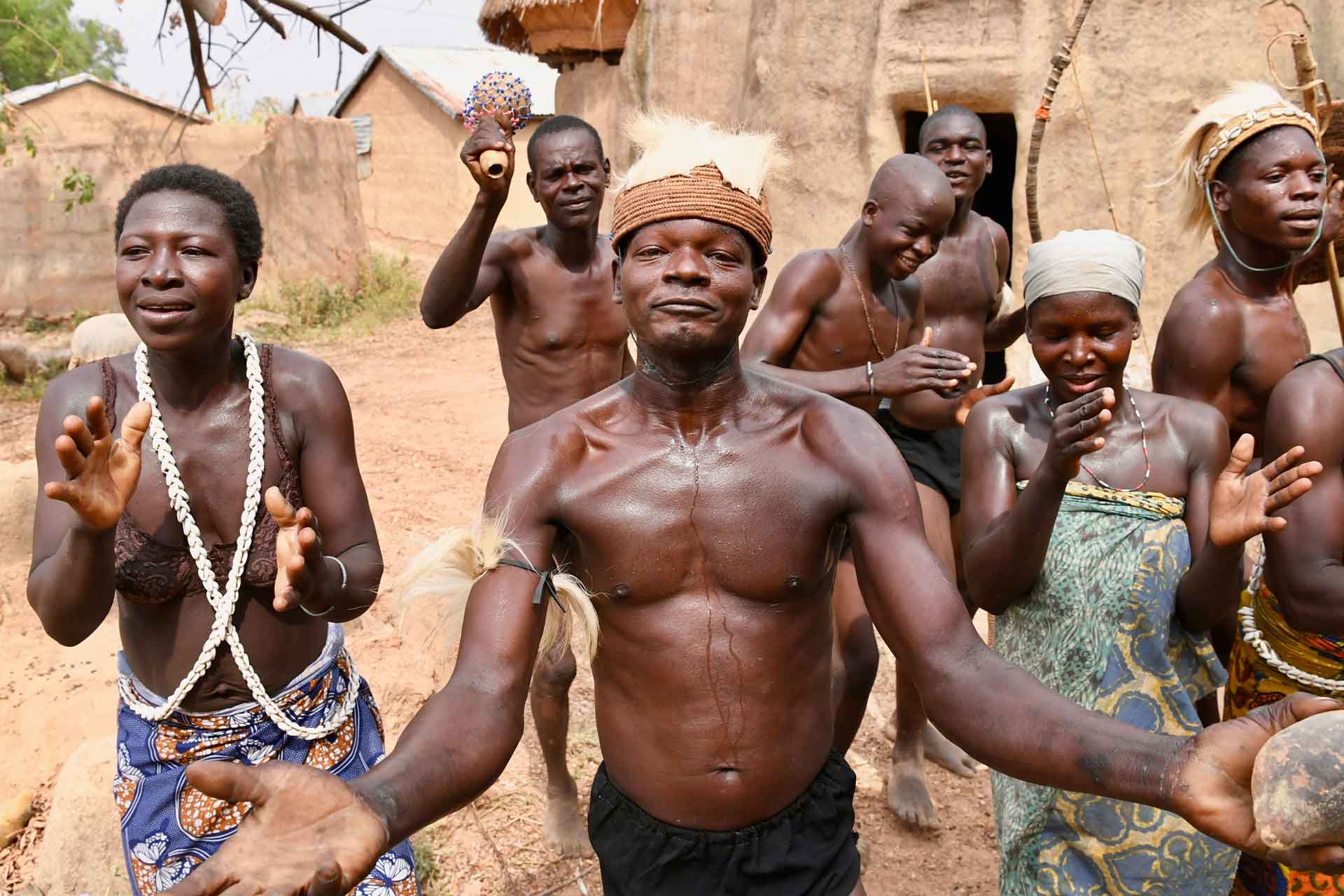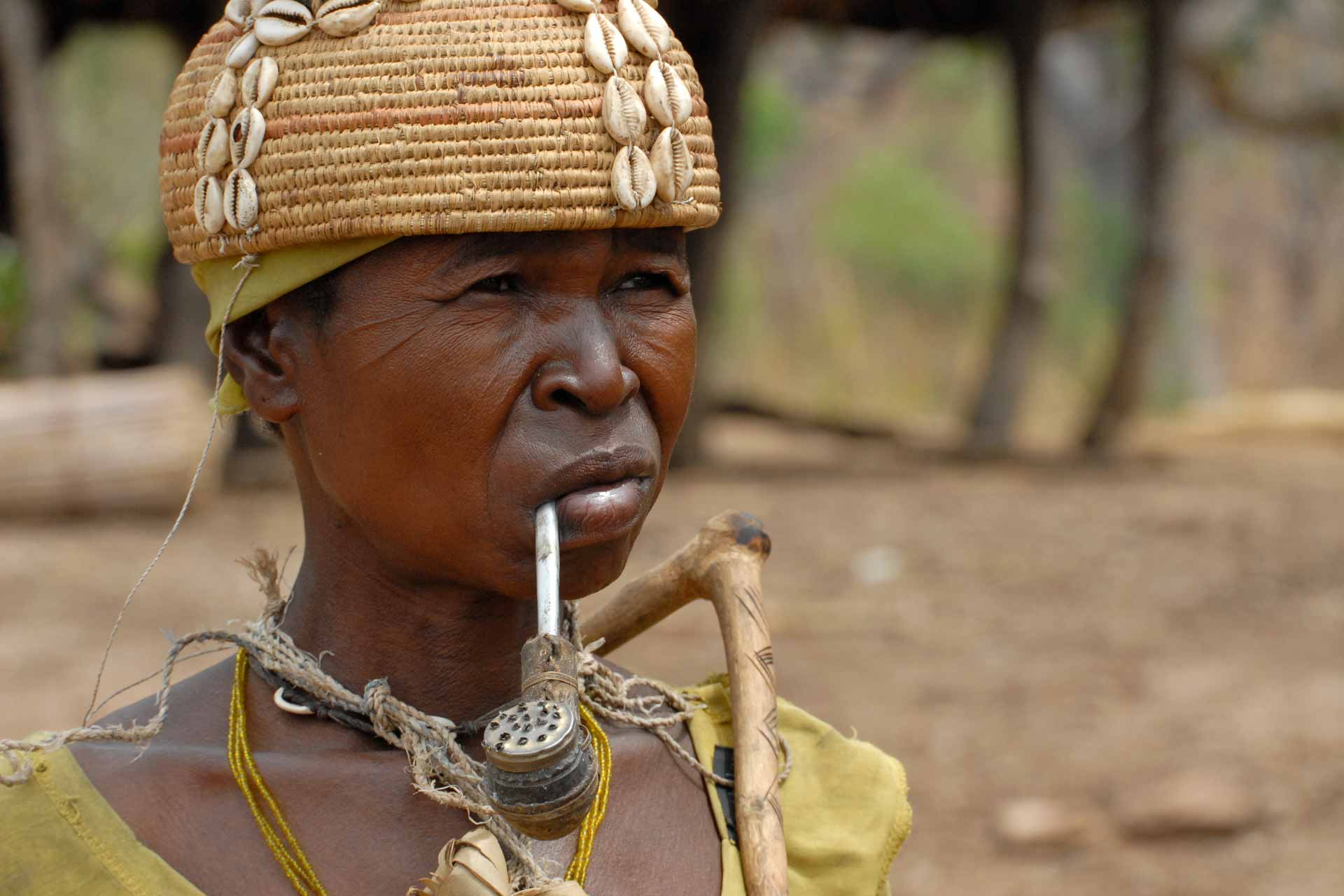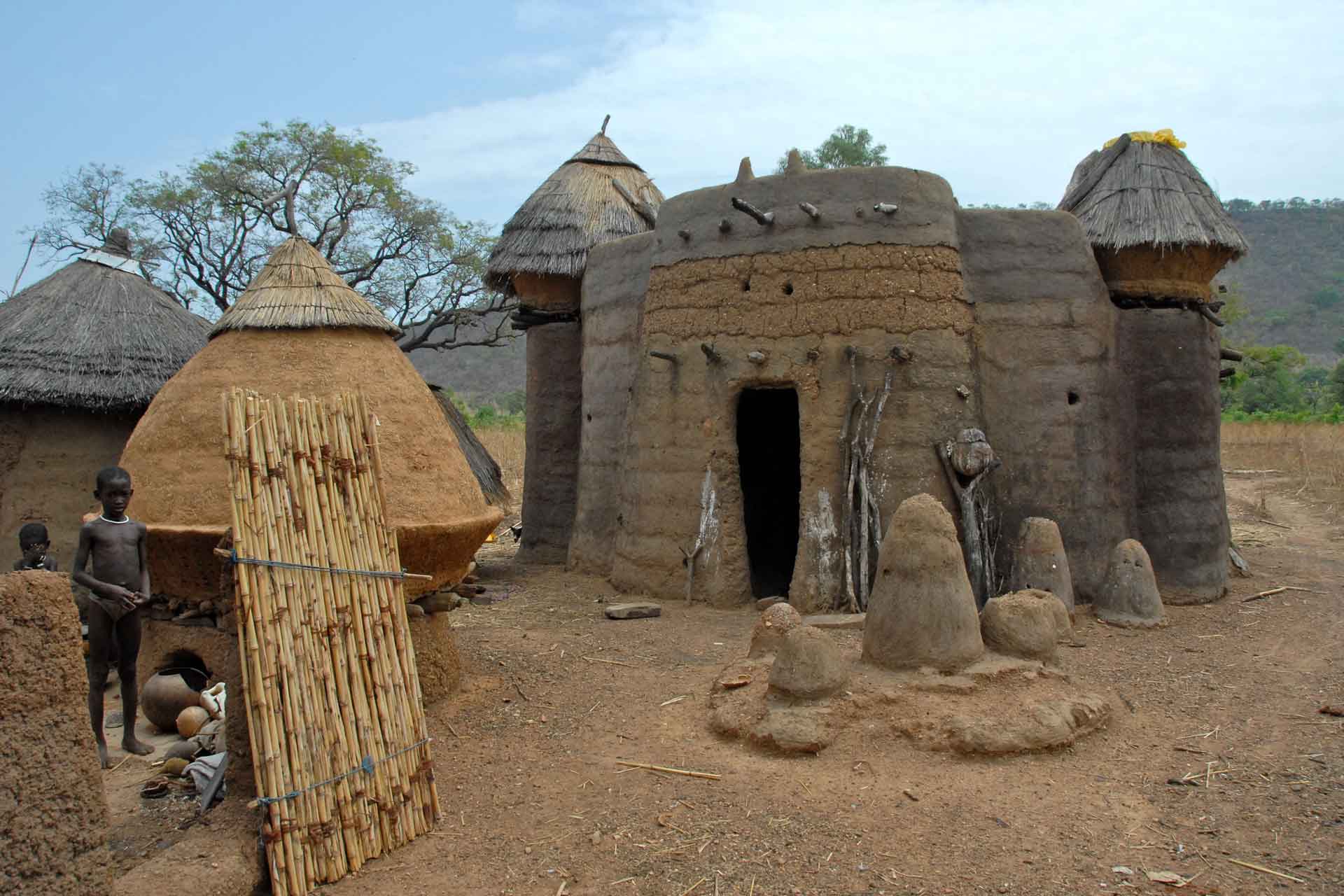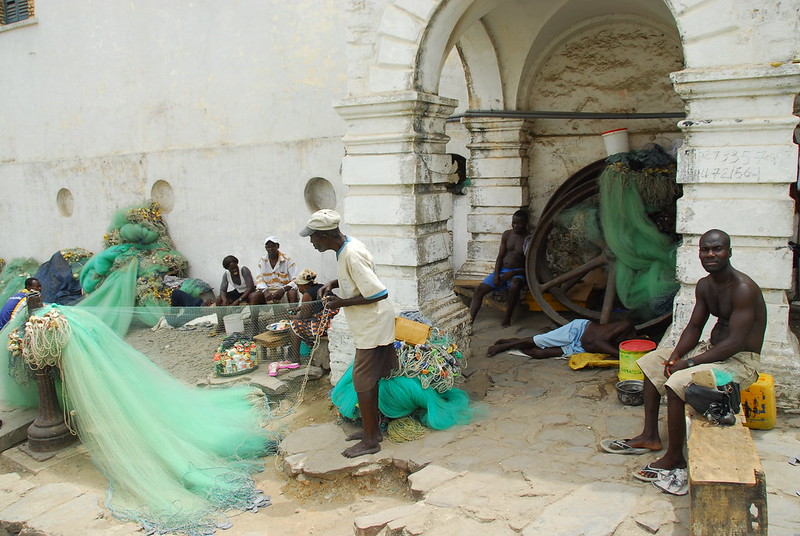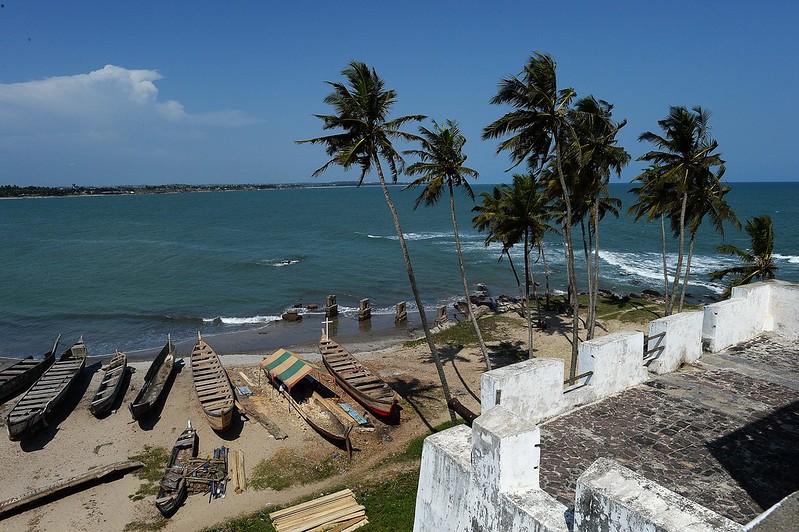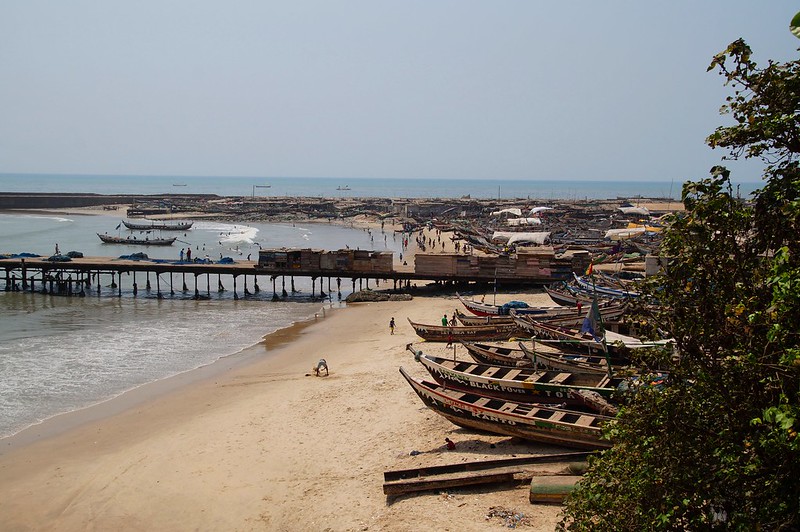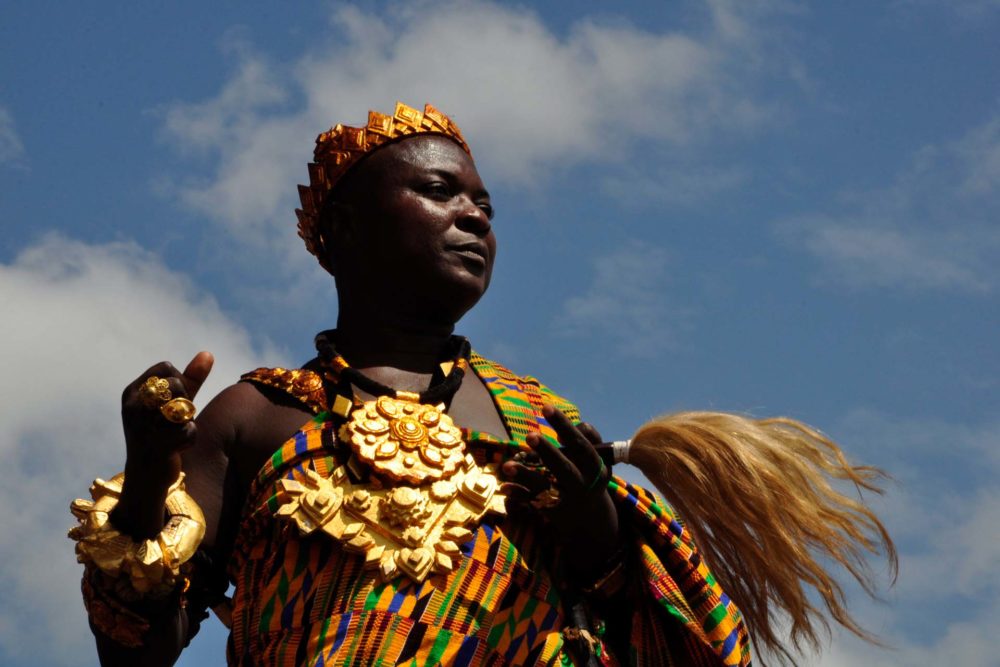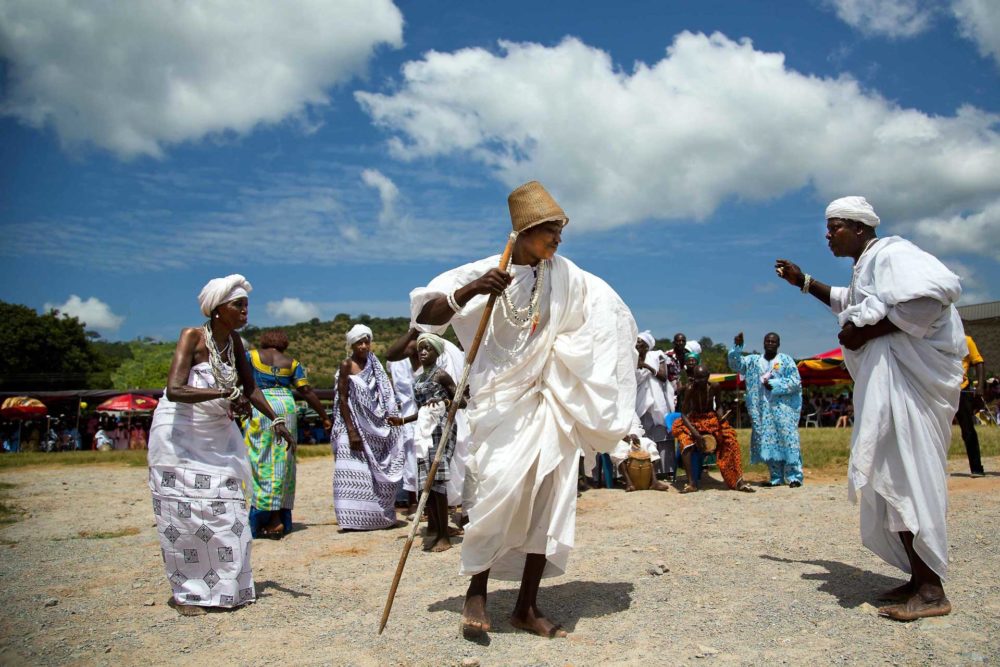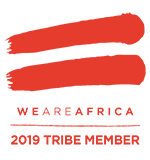Description
GHANA, TOGO & BENIN
January 10th is always a very special day in Benin, a day for celebrating ancestral cults.
We have the great opportunity to see the Festival in 2 cities: Grand Popo and Ouidah.
In Ouidah, they convey in a long procession to the Door of No Return, some on foot while others by motorbike or “taxi-brousse”.
They are all dressed up in traditional costumes, white being the dominant colour.
The Festival reaches its peak with the arrival of the Dagbo Houno, the chief “feticheur”.
Dances, libations, masks and some official speeches are all part of the morning programme.
Our fantastic cultural odyssey then heads inland, through northern savannah.
We discover the Taneka tribe on a rocky mountain, the Tamberma people with their fairy-tale clay castles and finally we enter the Ashanti kingdom in Kumasi where we meet a paramount chief. In this tour we see also the Akwasidae celebration in Kumasi, one more opportunity to experience local festivals.
We end our tour exploring the former Slave Coast, with its haunting European forts.
One of the most complete and spectacular tours in West Africa with 2 special festivals!
Great experience combined with the choice of good accommodation.
For travellers who want to get acquainted with this incredible region … and love Africa!
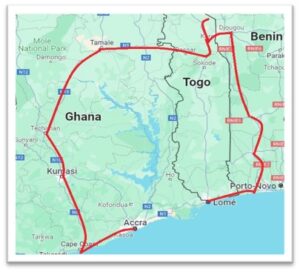
DAY 1: Lome, 08.01.2025 Gulf of Guinea – TOGO
Arrival in Lome (Togo) and transfer to the hotel.
DAY 2: Fetish market, 09.01.2025 from Lomé to Grand Popo (150 km – 3 hrs)- TOGO & BENIN
Lomé city tour. Lomé, the vibrant capital of Togo, is the only African city which was a colony of the Germans, the British and the French. It is also one of the few capitals in the world bordering with another nation. These elements have led to the development of a unique identity, reflected in the life-style of its inhabitants and in the architecture of the town: Lomé is indeed a cross point for people, trade and cultures, a cosmopolitan city in small size. We will visit: the central market with its famous “Nana Benz”, the women in control of the market of the expensive “pagne” (=cloth) coming from Europe and sold all over West Africa (unfortunately the market has been partially destroyed by fire); the colonial buildings in the administrative quarter where the flavour of colonial time is still very present; and the fetish market where we can find an eclectic assortment of all the necessary ingredients for love potions and magical concoctions.
In a remote village, we will join a Voodoo ceremony: the frenetic rhythm of the drums and the chants of the adepts call in the voodoo spirits who then take possession of some of the dancers. They fall into a deep trance: eyes rolling back, grimaces, convulsions, insensitivity to fire or pain. Sakpata, Heviesso, Mami Water are just some of the voodoo divinities who can manifest. In this narrow village, surrounded by the magic atmosphere of the ceremony, we will finally understand what people mean when they say: “In your Churches you pray God; in our voodoo shrines we become Gods!”
We drive to Grand Popo in Benin.
DAY 3: Voodoo festival,10.01.2025 Ouidah – BENIN
Every 10th of January is a national celebration day in Benin, honouring traditional religion. We start the day driving to a less known site where is also celebrate the Voodoo festival but in a more traditional way and without the participation of a large number of Tourist and a crowd coming from town, creating long lines of cars and congested parking lots. At our more intimate festival we will enjoy genuine Sacred Masks dances, Voudou followers with colourful costumes and red feathers, high animistic priest with their court of initiates, drumming, dancing and the enthusiastic participation of the villagers from the entire region.
Later we drive to Ouidah and the most famous festival in the country. Here in particular, dozens of voodoo ceremonies are held, calling thousands of adepts, traditional chiefs and fetish priests. We will see also different masks. The high ranked Voodo chiefs will be there wearing traditional costumes.
Since 2024, this official Voodoo festival is organized by a committee, and usually the scheduled of the festival will be announced closer to festival date.
DAY 4: Ganviè stilt Village, 11.01.2025 from Ouidah to Abomey (120 km – driving time 2 hr) – BENIN
This morning we complete the visit of Ouidah that was one of the main slave trading post. The old town enjoys a rare Afro-Brazilian architecture and a syncretic atmosphere where the Voudou Python Temple faces the Catholic Cathedral.
Drive to Lake Nokwe and with a motorized boat to reach Ganvié, the largest and most beautiful African village on stilts. The approximately 25,000 inhabitants of the Tofinou ethnic group build their wooden huts on teak stilts. Fishing is their main activity. Ganvié has managed to preserve its traditions and environment despite the long-lasting human presence in a closed setting; and the lake is not over-fished. Daily life unfolds in the dugout canoes that adults and children row with ease using brightly coloured paddles. Aboard these canoes, men fish, women expose goods at the “floating market”, children go to school and play.
Once returned to the mainland we drive to Abomey where we visit the Royal Palace (currently closed for refurbishment) or we will see other interesting areas of traditional Abomey,
DAY 5: Abomey,12.01.2025 from Abomey to Dassa (90 km – driving time 1.30 hr) – BENIN
Today, Sunday, we attend the service of the cult of Celestial Church.
Dozens of people, dressed in white, gather for a syncretic prayer, in which Christian symbols and animist sensibilities mix, resulting in a lively celebration, punctuated with prayers and scenes of possession.
We will also see the performance of the adept of Sakpata, the god of Smallpox, that dances with the breast covered by necklace of cowry shells, and of some humorous masks that makes acrobatic dances on stilts.
DAY 6: Fetish Priest 13.01.2025 From Dassa to Djogou (260 km 4 hrs) – BENIN
Dassa is the seat of an old kingdom founded by Olofin in 1385 and in town it is still possible to see sites witnessing the passage of this long-lasting dynasty. A walk through the hills will take us to a sacred place where kings used to be buried – it is still protected today by several voodoos. Later this morning we drive further North. We will see the Dankoli Fetish, a unique shrine for ancient animistic cults still practiced. Thousands of short sticks are pushed in and all around the fetish as testimony of the countless prayers for a good harvest, a happy wedding, an easy delivery, success at school etc. Once the prayers are answered, people come back to sacrifice what they had promised. Fresh traces of sacrifice, palm alcohol and oil on the fetish are witnesses of the many prayers and requests been fulfilled.
If lucky we can also meet with the Fulani. The Fulani are mainly shepherds. The men move around with their herds while the women take care of the camp as well as milk the cows and produce the butter to be sold at the market.
The Fulani are famous for their beauty. In fact, “Fulani” means “beauty”: Beautiful tattoos on their face send messages to the people who understand the language; beautiful slender bodies looking at their herds stand as a dot on the horizon; beautiful eyes able to contain so many landscapes contemplated during their migrations to find grazing. Their beauty is proportional to their slowness. Mysterious figures: they seem to be slower than anybody else and at the same time they move more than anybody else. Here is the mystery of a people who learnt how to tame time and space, history and geography.
DAY 7: Taneka Village on the rocky hills, 14.01.2025 from Djogou to Kara (70 km – driving time 2 hr) – BENIN & TOGO
Early morning, we discover a few old Taneka villages located on a mountain with the same name. The villages are made up of round adobe huts covered with a conical roof protected on the top by a terra cotta pot. The upper part of the village is inhabited by the young initiated and by the fetish priests who only cover themselves with a goat skin and always carry a long pipe. This ethnic group has been living on an archaeological site for centuries and it looks as if the first inhabitants (from Kabye tribe origins) moved to the mountain during the IXth century. Since then, other ethnic groups have joined thus forming melting-pot where even though each group kept its own cults and initiation rites, common religious and political institutions were defined.
As we wander around the villages along alleys bordered by rocks with ancient and mysterious carved marks, only witnesses of populations who in the past have lived in these places. We may come across young initiated, wearing only with a cover sex and magical amulets, or elder fetishes priest wearing a skin. Tanekas believe that in order to “become” a man, it is necessary to combine time, patience and many sacrifices. Initiation is a lifetime process until life itself becomes a rite of passage, therefore life should not be conditioned by a “before” and an “after” but rather as following a continuous path. (Please consider at least three hrs walk up and down hills on rocky steps)
We drive to the Togo border.
In the afternoon, we will enjoy an easy walk to discover Kabye villages living on the top of mountains to experience a spontaneous and friendly welcome. Kabye dwellings called «Soukala» are composed by several adobe huts joined by a wall – each dwelling is the domain of a patriarchal family. In the villages located at the top of the mountains, women are potters using an ancestral technique without the wheel while men are blacksmiths still working iron with heavy stones instead of hammers and anvil as in the early down of Iron Age. We follow the process of shaping a hoe.
We arrive in Kara.
DAY 8: Adobe Castles ,15.01.2025 from Kara to Sokode (75 km – driving time 2 hr) – TOGO
Driving North we enter the land of the Tamberma who live in adobe fortified dwellings. The shape is like small medieval castles, they are one of the most beautiful examples of traditional African architecture. Their style impressed Le Corbusier vanguard architect that describe it as «sculptural architecture». In fact, the houses are built by hand, layer of clay after layer, adding round mud balls and shaping them as per the plan of the house. A kind of sensual gesture mixing strength, care and beauty. Large shrines- of phallic form – at the entrance of their homes show their animistic believes. With the permission granted to us by the elders we enter their homes to better understand their way of life.
Actually their houses are projections of their cosmology – the ground floor, with its darkness, represents death and is the place of the ancestors; the second floor, open to the sky, represents life and is the place where grandmothers keep babies until they “find out” which ancestor has come back as the new life – only then the baby will be allowed to come down from the terrace.
All – family, food supplies and stock – are kept inside the fortified house, for safety reasons in case of attack by enemies. For centuries these populations have been seeking refuge on the Atakora Mountains to escape Muslim slave traders coming from the north.
In the evening, we arrive at the villages of Tem tribe to discover the fire dance. At the centre of the village a large fire lights up the silhouette of the participants. They dance to the hypnotic beat of the drums eventually leaping into the glowing embers, picking up burning coals, passing them over their bodies and even putting them in their mouths and swallowing them. all this without hurting themselves or showing any sign of pain. It’s difficult to explain such a performance. Is it matter of courage? Self-suggestion? Magic? Maybe it really is the fetishes that protect them from the fire.
DAY 9: Witches, 16.01.2025 from Sokode to Tamale (290 km – driving time 6 hr) – TOGO – GHANA
Ghana border. Dagomba tribe live in this savanna region. They build round clay huts with a thatched roof. The village chief’s house is characterized, at the entrance of its compound, by a large hut with a central pole supporting the roof. It is here that the council of elders meets. The entrance is framed by pieces of burnt coloured clay.
In one of these villages, we meet a very large settlement of … witches, exiled from their villages. We will discuss with them about their life in the village and how they are protected by a special shrine, in charge of “cleaning” their spirits from bad wills.
DAY 10: Sacred monkeys, 17.01.2025 from Tamale to Techiman (270 km – driving time 5 hr) – GHANA
Transfer to the South.
In the Brong Afo region we will leave the main road and follow a track to a sacred forest. The population living there considers the Monas and Colobus monkeys as their totems. As result we have the largest community of these species in the world.
Walk in the forest trough giant trees and an emerald green light. We will meet plenty of sacred monkeys.
DAY 11: Ashanti, 18.01.2025 from Techiman to Kumasi (130 km – driving time 4 hr) – GHANA
Kumasi is the historical and spiritual capital of the ancient Ashanti Empire. Ashanti was one of the most powerful empires and kingdoms in Africa from 1670 to 1957 when British Gold Coast become the independent Ghana. The tribute paid today to the Asantehene (King) is the best evidence of their past splendour and strength and the still strong Ashanti pride. With nearly two million inhabitants, Kumasi is a sprawling town with a unique central market, one of the largest in Africa. All kinds of Ashanti craft (leather goods, pottery, beads, textiles called Kente cloth, etc.) are found here, along with just about every kind of tropical fruit and vegetable.
The program includes a visit to the Ashanti Cultural Centre: a rich collection of Ashanti artefacts housed in a wonderful reproduction of an Ashanti house. In the afternoon we participate – if available – in a traditional Ashanti funeral, attended by mourners wearing beautifully red or black togas. We say “funerals” but it means a “festive” celebration: thanks to this ceremony the deceased return as an ancestor and will protect his family. Relatives and friends gather, socialize, and celebrate his/her memory. The chief arrives surrounded by his court under the shade of large umbrellas while drums give rhythm to the dancers whose intricate moves are highly symbolic in war and erotic meanings.
DAY 12: Akwasidae , 19.01.2025 Kumasi (transfers) – GHANA
Today is a very special day in Kumasi, because there is the Akwasidae
Akwasidae Festival In the Ashanti calendar certain days each year are set aside for a very special celebration at the Royal Palace. We will experience a great traditional ceremony in one of the last African Kingdoms, which still practices its ancient rituals in full. During the celebration, the King sits under a large colourful umbrella, adorned in vivid cloth and massive ancient jewellery (Ashanti gold jewellery are considered masterpieces of African art), surrounded by dignitaries and elders, and on the side of the King sits the Linguist holding the golden symbols of power. The position and distance from His Majesty represents all roles and positions of power in the royal court. The ceremony starts with a procession: attendants bringing gifts, story tellers reciting the deeds of the past Kings, drummers and ivory trumpet players, sword bearers, armed guards, carriers of ostrich feather fans, high fetish priests, and corpulent women dressed in vivid red performing dance with erotic symbolism. The Queen Mother joins the ceremony surrounded by her court. We will experience the splendour and intense atmosphere of one of last great African Monarchies of the forests.
We visit the Royal Palace Museum hosting a unique collection of gold jewels worn by the Ashanti court.
DAY 13: Slaves’ Castles,20.01.2025 from Kumasi to Anomabu (250 km – driving time 4 hr) – GHANA
Drive to the coast. The coast of Ghana (formerly known as Gold Coast) has more than 50 ancient forts and castles, reminiscent of the ancient gold, ivory and slave trade. We reach Elmina Castle, the oldest European building in Africa, erected by the Portuguese in the 15th century. At different times, the castle has been used as a warehouse to trade gold, ivory, and eventually slaves. The castle we visit today is the result of successive extension works and is recognized as a UNESCO World Heritage site. The old Dutch Cemetery in Elmina goes back to 1806. Outside the castle, there is a spectacular fishing village with lots of large colourful fishing boats – every day these large wooden pirogues conducted by skilled fishermen across strong ocean waves and currents, “fighting” to earn a living. In a nearby village, we will see the Posuban, the shrines of the ancient “Asafo companies” – the warriors who used to put their offerings on the large colourful statues.
DAY 14: Metropolis,21.01.2025 from Anomabu to Accra (180 km – driving time 3 hr) – GHANA
Drive to Accra.
Accra, the capital of Ghana, has kept its unique identity despite the fast-paced development of the last decades with its modern buildings and large avenues. The luxuriant administrative area, punctuated with elegant villas built during the first half of the 19th century, reminds us that was the most flourishing colony in Africa.
We explore James Town historic neighbourhood, inhabited by Ga people. Facing the Ocean is where native people life fully unfolds: a village surrounded by the city! Here all economic activities follow very different rules from the ones governing “the city” (business area), just a few hundred meters away. We continue with the visit of a workshop specialized in “fantasy coffins”. These unique handcrafted coffins can reflect any shape: fruits, animals, fish, cars, airplanes…. the only limit being imagination! Started in Accra, these flamboyant coffin designs are by now collected worldwide and exposed in museums.
In the evening transfer to the airport for the flight out.

